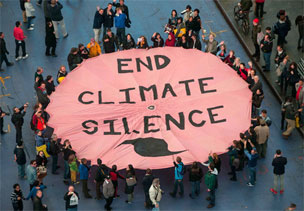by Rona Fried
Sitting here on Long Island, we are awaiting the worst of Hurricane Sandy. I expect our electricity to go out later today – given the depth of the storm, we’re hearing electricity may not be restored for up to a week.
The storm is still 250 miles away, but to have the "largest hurricane in Atlantic history" barreling our way stirs a level of trepidation I’ve rarely felt in my life.
Growing up, I never had to worry about weather events like this. All during those years, living in the New York area meant reliably moderate weather. No really big storms, no big worries.
Those days are gone.
Right now, the water levels around NYC are where they were at the height of Hurricane Irene. One year later, officials expect them to be more than two feet higher. If they rise to 10 feet or more, salt water will enter the subway system, flooding it and corroding key parts, like switching signals.
Sure, these parts will be fixed and subways will run again, but what will next year’s even more mammoth storm bring?
Luckily I don’t live near the water, but I’m surrounded by trees. Living through two solid days of sustained 50 mile per hour winds – surging to 80 mph – is plenty scary.
And this storm is affecting the entire eastern third of the country with a diameter of 1100 miles. From Georgia to Maine and from Long Island to Ohio, people are feeling this storm. West Virginia may get three feet of snow.
The National Weather Service calls it "A storm like no other. "I cannot recall ever seeing model forecasts of such an expansive areal wind field with values so high for so long a time. We are breaking new ground here."
"History is being written as an extreme weather event continues to unfold, one which will occupy a place in the annals of weather history as one of the most extraordinary to have affected the United States, says Senior Meteorologist of The Weather Channel.
"A meteorologically mind-boggling combination of ingredients coming together: one of the largest expanses of tropical storm (gale) force winds on record with a tropical or subtropical cyclone in the Atlantic or for that matter anywhere else in the world; a track of the center making a sharp left turn in direction of movement toward New Jersey in a way that is unprecedented in the historical database, as it gets blocked from moving out to sea by a pattern that includes an exceptionally strong ridge of high pressure aloft near Greenland; a "warm-core" tropical cyclone embedded within a larger, nor’easter-like circulation; and eventually tropical moisture and arctic air combining to produce heavy snow in interior high elevations. This is an extraordinary situation, and I am not prone to hyperbole," he says.
Hurricane Sandy is likely to cause insured losses of $5 billion to $10 billion and economic losses of $10 billion to $20 billion, disaster modeling company Eqecat says.
Even if losses are at the low end of that estimate, Sandy would rank as one of the worst hurricanes in history by insured losses. Last year’s Hurricane Irene resulted in $4.3 billion in insured losses.
But while Sandy is all over the newspapers and TV news, a Nexis search found ZERO of these stories mentioned "climate change," "global warming," or even "extreme weather."
Yesterday, in Times Square, 350.org unfurled the giant parachute below.

"Manmade climate change is one monster we still have some control over. But here’s the final warning. We are already seeing Frankenstorms, and we’ve only warmed about 1.4°F over the past century. We are on track to see more than 5 times that warming this century. The monster storms that would spawn are beyond imagining," says Joe Romm of ClimateProgress.

Indeed, the lack of news coverage about one of the main drivers of why ‘Sandy’ became so powerful is alarming. The ribbon of warm water that is the Atlantic Gulf Stream injected plenty of additional fuel to ensure that when Sandy collided with that cold front, well, WHAM!
This really should be old news by now: Katrina showed us the power of a heated Gulf of Mexico (undoubtedly caused by man-made climate change). Heck, my college professors predicted these kinds of events over 25 years ago!
Thus I was somewhat (and pleasantly) surprised, when just days before the elections, Obama spoke out about how climate change grew Sandy into a Super-storm. Also surprising, The Weather Channel finally did a segment about climate change and the increasing severity of storms – though I only saw it run after midnight… maybe they figure insomniacs are better disposed toward reality.
What also bugs me is how mainstream news features as hero’s all the hard-working storm victims fervently stating how they’ll rebuild right in the same spots! Oy.
Thanks for posting that wonderful picture of the folks with the giant parachute sign in Times Square:
“END CLIMATE SILENCE”